December 6, 2021
Dear Friends and Neighbors,
Following the 2012 State Supreme Court’s McCleary decision regarding education funding, the Legislature made significant additional investments into K-12 education funding and also limited amounts school districts could seek in local property tax levies. The property tax limits, which I supported, did not hold up for long. As the political dynamics changed in Olympia, the cap was removed just a couple years later. In the years that have followed, taxpayer funding of education has continued to increase, and the scope of services provided by our school districts continues to expand.
So much focus has been placed in recent years on state education funding and school levies that many people may not realize the important role local school boards have in developing priorities, approving annual budgets, and overseeing operations. School districts are actually local governments, not state agencies. They are governed by their own elected boards and administered by chosen school superintendents. Districts receive the majority of their funds from state dollars on a per-student basis along with local and federal funds. School districts should prudently invest their taxpayer dollars (local, state, and federal) to implement their programs, negotiate sustainable contracts with their employees, and manage their operations. Districts still maintain a great deal of flexibility to operate their schools or to partner with neighboring school districts.
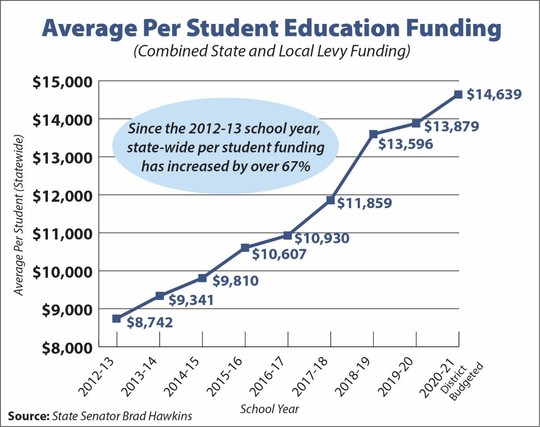 Over the past several years, per-student education funding in our state has significantly increased. This is partially due to state funding increases in response to the 2012 State Supreme Court's McCleary decision, as well as school districts seeking voter approval for increased taxes in their local school levies.
Do districts spend the same amount per student?
No, the school districts do not all spend the same way. Washington state has 295 different school districts. These school districts range from very small districts, such as the Stehekin School District on Lake Chelan with 10 students to the Seattle School District serving nearly 55,000 students. As a result of local school district control, state funding formulas, and local levy requests, each school district’s expenditures vary. Generally speaking, the cost per student in the small school districts is much higher than those of the medium to larger districts. While smaller school districts may enjoy slightly more flexibility in operations over larger districts, the smaller school districts do not necessarily support lower class sizes or more student options and there is likely an efficiency impact to their operations as well as a cost to the taxpayer. In North Central Washington, for example, the per student expenditures are higher in the school districts of Palisades ($28,745 per student), Mansfield ($26,342 per student), Orondo ($22,125 per student), and Waterville ($18,799) than the state average of $13,879. Those costs are significantly greater per student than neighboring Eastmont ($13,737), whose average per-student expenditures is below the state average. The chart below includes districts near Eastmont given its efficient size and operations. I also include Lake Chelan and Manson school districts in the chart because of their proximity to each other, but there are additional examples of consolidation possibilities in other areas of North Central Washington and throughout the state.
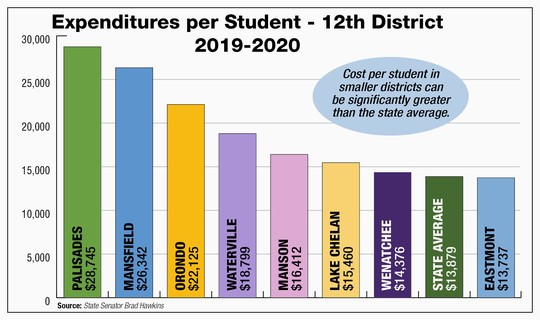 Expenditures in the school districts of Palisades ($28,745 per student), Mansfield ($26,342 per student), Orondo ($22,125 per student), and Waterville ($18,799) are far greater than the statewide average of $13,879 and significantly greater than nearby Eastmont ($13,737 per student). Questions to consider based on the data:
- Should Mansfield and Waterville consider partnering as one district?
- Could Orondo, Waterville, or Palisades consolidate with Eastmont?
- Would Manson and Lake Chelan function more efficiently together?
- What other school districts in our region or state could team up?
My bill would incentivize voluntary consolidation
I have long wondered why Washington state has 295 different school districts and whether that is the best approach for students and taxpayers. Based on my nearly 10 years as a school board member and my nearly 10 years of experience as a legislator working on education issues, I believe small school districts could potentially benefit from merging with their larger neighboring districts or with similar-sized smaller districts. Strategic consolidation could create more efficiencies for taxpayers by driving down the per-student expenses while expanding options in academics and activities. The issue of school consolidation has certainly been raised before, and it can be controversial. However, past proposals have included the assumption that the state would reimagine district boundaries and force consolidations. My proposal incentivizes voluntary consolidations. Click these links to review my proposal, Senate Bill 5487, and PowerPoint presentation.
The bill I plan to sponsor next session could help resolve inefficiencies in the per student expenditures among the smaller districts while helping districts renovate and modernize their facilities, a concern often shared by the smallest districts. My bill concept would temporarily enhance the state’s School Construction Assistance Program (SCAP), which provides matching funds to school districts that pass construction bonds at 60 percent, for smaller school districts that voluntarily consolidate with their neighboring districts. The school facility modernization formula would be enhanced for 10 years following consolidation, so that both the smaller school district and the district it merges into could receive greater state matching dollars for future school facilities. This idea could encourage small school districts to consider voluntary consolidation, create more efficiencies for the taxpayers who fund per-student costs, and assist smaller districts (and their larger neighboring districts) with much-needed modernizations.
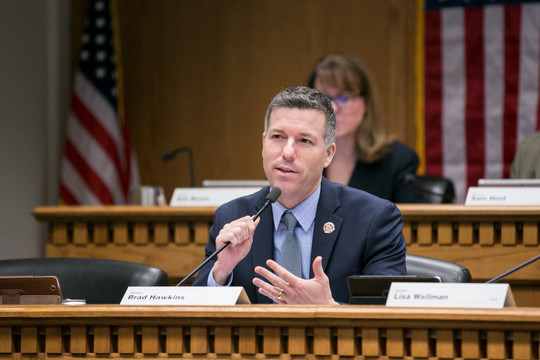 As the ranking Republican member on the Senate’s Early Learning and K-12 Education Committee, I work closely on statewide education policy issues. Prior to being elected to the Legislature, I served for nearly 10 years on the North Central Educational Service District and Eastmont School boards.
Should some local school districts consolidate?
School districts have certainly adapted to many changes in recent years, including adjustments to school funding, remote learning, and COVID protocols. Asking them to take on the additional challenge of voluntarily considering consolidating with a neighboring school district could be a tall order. However, our region has seen recent benefits from consolidations among other local governments, including Wenatchee-based fire districts and the Chelan-Douglas Regional Port Authority. Washington state law (RCW 28A.315.235) provides a clear process for school districts who choose to consolidate, including community votes of the two school districts. Exploring consolidation should include extensive public outreach and engagement. Districts and communities should consider academics, sports, club activities, student transportation, collective bargaining contracts, facilities, local tax structure, school identity, and other factors.
 This graphic shows some comparisons between statewide average costs and that of districts near Eastmont. Statewide data show that smaller school districts usually have greater costs per student, often related to central administrative, building administration, and facility maintenance expenses.
Exploring consolidations is certainly a conversation some of our local school districts could have with each other. Those discussions could lead to collecting public comment well before any potential community votes. While the decision would ultimately be made locally, after much consideration, the data would suggest that it could be something some of our local districts might want to explore. For example, could Palisades, Orondo, or Waterville school districts (or any combination thereof) merge with Eastmont? Would it be more efficient and effective if Orondo, Mansfield, and Waterville school districts combine into one district? Would Manson and Lake Chelan school districts – although their per-student costs are not significantly greater than the state average – be better together? Would some other school districts in Chelan County consider partnering together or with Wenatchee School District? What are the opportunities to explore in Okanogan and Grant counties or statewide? Similar to my 11th month school calendar bill from last session, I plan to continue to encourage my legislative colleagues and others to think differently about our educational delivery system. Taxpayers are investing too much for us to do otherwise.
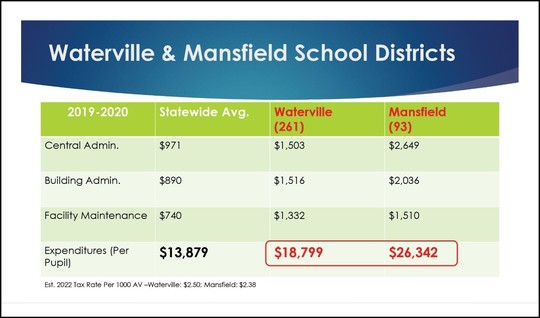 Waterville and Mansfield – as another example – are two school districts in our region that could consider joining forces through consolidation. Their per-student costs, which are very common for smaller-sized districts, are much greater than the state average. As seen with Mansfield, certain costs often grow as districts get smaller. Could some expenses be more efficiently shared as one district?
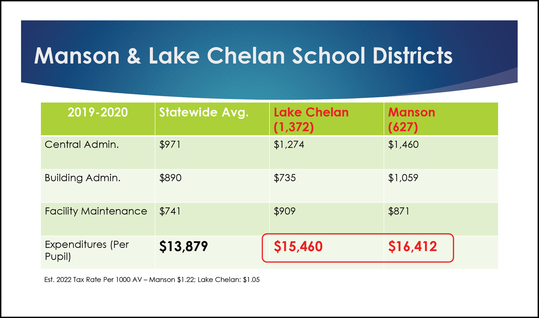 As another local example, Manson and Lake Chelan school districts could consider consolidating. While their per student expenditures are not nearly as high as some districts, their costs are greater than the state average. Like most comparisons, student demographics is a cost factor and could result in higher overall expenditures, but savings in administration and maintenance could be substantial. If we were to design school district boundaries for the first time today, would it make sense to have Manson and Lake Chelan as separate districts? Since Manson is nearby along the lake, combining students into “Lake Chelan School District” is a reasonable topic for consideration.
Listen to my recent local radio interviews
During the interim when the Legislature is not in session, I call our local radio stations monthly to participate in live interviews about legislative issues. If you'd like to hear my most recent interviews, click on these links for KOHO and KOZI. A few weeks ago, I participated in an interview on KPQ’s “The Agenda” with Dave Bernstein. We discussed the proposed boundaries for the 12th District released in November by the state Redistricting Commission. Click on this link to listen to my Full KPQ Interview. If you have any questions, please contact me anytime.
Thank you for the opportunity to serve as your 12th District state senator.
Sincerely,

Brad Hawkins
State Senator Brad Hawkins
12th Legislative District
Website: senatorbradhawkins.org
107 Newhouse Building - P.O. Box 40412 | Olympia, WA 98504-0412
(360) 786-7622 or Toll-free: (800) 562-6000
|